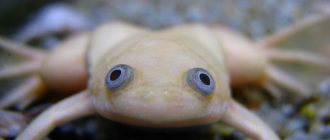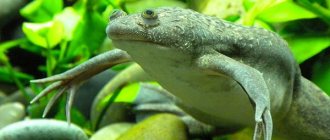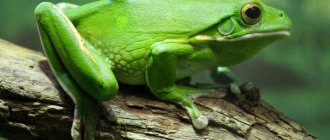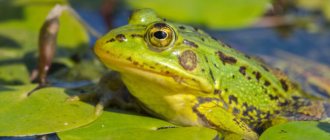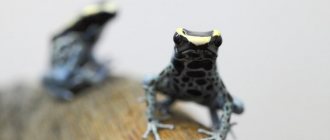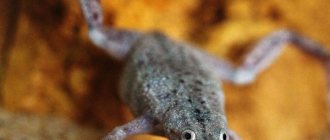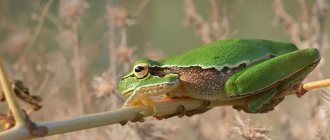Not only fish are kept as aquarium inhabitants. For example, a frog can become a pet. It does not require a large volume of water to maintain. Aquarium frogs can easily live even in a 5-liter container. They funny hang in the water or swim like little divers. Amphibians are very interesting to watch, and care does not require much trouble.
Description
Clawed frogs are the most ancient amphibians. Their fossil remains have been discovered, dating back 1.85 million years.
A smooth frog from the order of tailless amphibians of the spiny family. It is classified in this family due to the presence of spur-claws up to 3 mm long on three toes of the hind legs. They are needed to float on water, cling to plants, protect themselves from enemies and hunt. Because of them and their natural habitat, the smooth clawed one received another name - the African clawed one.
The clawed frog has three powerful claws on its hind legs.
Although this frog is classified as an amphibian, it cannot live without water. In the wild, it comes to land only in severe drought to find a new suitable habitat.
The smooth frog can swim quickly, but in aquariums it mainly sits in bottom shelters or hovers in the water column. She can rush around the aquarium, knocking down everything around her, only out of fear.
With low mobility, smooth frogs receive a third of the necessary oxygen through skin respiration, and with active life activity the share of such respiration is 10%.
Every 10 minutes the amphibian has to surface to breathe air.
Systematically (once every few weeks), frogs shed and eat their skin.
Based on the study of these amphibians, scientists have made many discoveries in the field of embryology and developmental biology.
Toadstool
The most common subspecies are red-bellied, yellow-bellied and Far Eastern. They have a bright spotted color, which seems to warn of danger. The poison frinolicin, which is secreted by the mucous tubercles of the amphibian, is not dangerous for humans, but it is necessary to wash your hands after contact with the toad. Frogs grow up to 3.5-7 centimeters, males are territorial, so fights may occur at first. Fire-bellied toads are easily tamed; they can receive food based on a conditioned signal, sit on their hands, and predict the weather. To keep frogs you will need an aquaterrarium (5 liters is enough for two individuals). Temperature is 20-25 degrees, at night it can be lowered by 3-5 degrees. The soil is sand or gravel, you need shelters, stones, plants. The main food is invertebrates and insects. Fire toads cannot be kept with tadpoles; they eat them, just like small fish.
Types of clawed frogs
Of the well-studied species of clawed frogs, twenty are known. But only 5 of them took root at home.
Albino
The most popular of all smooth aquarium frogs. What is attractive about the albino clawed frog in comparison with other species, in addition to its unusual color, is their size - up to 16 cm in length.
The average length of an albino clawed frog reaches 16 cm
They get used to a person faster and are more sociable with him.
Albinos love solitude, which allows them to be kept in a shallow aquarium with a water volume of 8-10 liters.
Smooth spur
The most famous species of these clawed amphibians. Smooth is named because of its smooth skin covered with mucus. It is almost impossible to catch it with your hands and hold it in them.
The smooth clawed frog has very slippery skin.
Relationships with fish and plants
If you want to get yourself a white aquarium frog, then you should keep in mind that it is simply insanely active, and you must be prepared for this in advance. If there are any other inhabitants in the aquarium, then they cannot be housed together with such a representative of amphibians, since he really likes to chase fish throughout the space. Another possible option is that the latter will be eaten, and you may not even notice it at first.
That is, albinos definitely should not be in an aquarium with domestic fish, since these frogs are very fond of meat and therefore can absorb a good part of your aquarium inhabitants. In addition, the frog is incredibly active, and therefore the soil will be dug up and the water will become cloudy very quickly, which is often painful for most types of fish.
However, there is information about the beneficial properties of the mucus that an albino secretes - it has antibacterial properties and can cure sick fish. Only in this case is it worth placing the unfortunate creature in the water where the frog sat for some time, but not combining these two creatures. Otherwise, you risk simply driving away an already sick fish.
Due to the playfulness of frogs, you will most likely be missing some, or perhaps all, plants in the aquarium. These “blonds” really like to dig holes, pull out plants and drag them around the entire tank.
Keeping the clawed frog
It is possible to keep a clawed frog in captivity alone, but their behavior in groups is most interesting. At the same time, in order to avoid unnecessary conflicts among amphibians, it is desirable that the number of males be greater than females.
Even a beginner can easily keep and care for the African clawed frog. They only need clean and cool water.
Such amphibians must be handled very carefully because of their delicate skin. They are also very slippery and can easily slip out of the owner’s hands.
Handle the clawed frog with extreme caution.
Aquarium
Clawed frogs need to choose a long, shallow aquarium, since amphibians mainly move along its bottom. Depth is not so important for these amphibians, but significant space for swimming and jumping is an important condition for their maintenance.
They don’t need an island of land, so you can fill the aquarium with water so much that there is a small air space left for the frogs to breathe in atmospheric air at any moment.
The formation of an oily film on water is an unacceptable phenomenon, because when inhaling air the frog can be poisoned.
To maintain one specimen you need 30-40 liters of water. Although for three pets a capacity of 80 liters would be quite suitable. But keeping 2 frogs in an aquarium with 40 liters of water is no longer possible.
To keep clawed frogs you need a spacious aquarium
The aquarium must be covered with a glass lid, because African clawed frogs are jumping frogs. But on land they do not live very long, because they dry out very quickly. If the lid closes the aquarium tightly, be sure to make holes on one of its walls for air ventilation.
Water parameters
Smooth clawed frogs can live in water of any hardness, but cannot tolerate high levels of nitrites and ammonia.
You cannot use water for an aquarium with this frog that was poured straight from the tap. Chlorine and similar toxic substances in such water have a detrimental effect on amphibians. Before introducing amphibians into the aquarium, the water should sit for several days.
Using a special thermometer lowered into the water, regularly measure the temperature of the water in the aquarium to maintain a comfortable temperature for the frogs - from 19 to 21 degrees. Albinos need warmer water - 20-23 degrees.
Frogs prefer cool water with a temperature of 19-23 degrees Celsius
Substrate
The substrate replaces the soil in the aquarium and makes it easier to maintain order in it. It is better to use a substrate or fabric of dark colors that contrast with the inhabitants of the aquarium. This is necessary so that the frog can be clearly seen. Photos of your pet in such conditions will be very impressive.
Priming
There are two approaches to choosing soil in an aquarium for clawed frogs. You can not put soil in the aquarium at all. Or you can use smooth large pebbles as a substrate of such a size that they do not fit in the frog’s mouth. Moving along the bottom, the amphibian touches pebbles, which can float up, and the frog can swallow them by inertia.
Large pebbles can be used as soil for an aquarium.
The soil must be absolutely clean. Stones brought from the street should be boiled before being placed in an aquarium with an amphibian. Lay a layer of substrate 4 cm thick.
It is not recommended to fill the bottom with sand, as pets constantly dig it up, causing the water to become very cloudy.
Decor
To use decorations in an aquarium with an African frog, they must be:
- large so that the amphibian cannot swallow them;
- heavy so that she does not move them from their place;
- without sharp edges and at such a distance from each other to avoid injury to the amphibian during jumps;
- shelter decorations should have a wide entrance so that the adult does not get stuck.
Decorations in the aquarium must be made of safe materials
Compliance with all these conditions will help protect nervous individuals at the moment of their fear from painful and sometimes fatal injuries.
Plants
Vegetation in the aquarium where the clawed frog is kept is used both artificial and live. Although both can create problems.
Large pebbles are not suitable for living plants for rooting. Therefore, the right decision would be to plant them in pots. Pets also tear them with their claws and teeth.
Stiff-leaved and bitter-tasting Anubias, Echinodorus or floating Elodea, Pistia, and Hornworts are considered more suitable.
Anubias
Echinodorus
Floating Elodea
Pistia
Hornworts
Artificial plants often cause stress to the smooth frog because he cannot tear them up. This will not stop her, and she will most likely hurt her paws.
Shelters
Arranging shelters with suitable parameters for this amphibian is necessary. You can place driftwood, grottoes, halves of coconuts, and ceramic pots along the entire bottom of the aquarium of the appropriate size. Smooth frogs will hide there if necessary.
Filtration
African clawed frogs eat a lot of food, which means they also produce a lot of waste. In search of food, amphibians actively dig up the soil. As a result, the water quickly becomes polluted and becomes cloudy. It increases the content of nitrogen compounds harmful to the life of the pet. Therefore, filtering the water in such an aquarium is a necessity.
An aquarium filter is a mandatory attribute for aquariums with African frogs.
The optimal filtration rate is 10 aquarium volumes per hour. For this process, it would be correct to use powerful hanging or canister external filters.
You can also use an internal filter, but keep in mind that African claws cannot tolerate strong currents. But at the same time, water flow dividers installed in the aquarium can significantly reduce the performance of the filters.
Lighting
Clawed frogs are indifferent to light intensity. Any light is suitable for them. But still, daylight hours for them should not be longer than 12 hours. Lamps should be turned off at night.
Light should be selected based on its need for plants planted in an aquarium with a frog.
African frogs tolerate any type of light
Lighting lamps must be positioned so that they do not overheat the water.
For albinos, bright lighting is generally contraindicated. Excessive light leads to retinal damage and incurable blindness.
Cleaning
You should change the water (at least 20% of the total volume), as well as clean the aquarium, weekly.
The water used for replacement should stand for 2-3 days. You can add a special conditioner to it, which will quickly clean tap water of chlorine and make it suitable for frogs to live in.
The aquarium needs to be cleaned every week.
Carefully remove waste from the filter, glass and soil.
Do not use detergents to wash the soil and decorations.
Feeding
In nature, clawed frogs feed on small fish and a variety of invertebrates. In captivity, amphibians are not picky when it comes to food, but remain predatory animals. Therefore, when feeding at home, the menu for them must include mealworms and earthworms, moths and fry. They also love liver, meat and pieces of shrimp.
Claw frogs need to be fed a variety of foods
Amphibian pets will be happy to eat a ready-made mixture that is balanced for them:
- in dry form;
- granular;
- sublimated;
- mixed from live food;
- frozen.
Under no circumstances overfeed them, as this can lead to obesity. Juveniles should be fed once a day, and adults a couple of times a week.
It is prohibited to feed these amphibians with goldfish or other ornamental fish, which may cause excessive accumulation of vitamin B.
What to feed a white frog in an aquarium
The clawed frog is most often chosen to be kept in a home aquarium.
In the albino version, it is light yellow or white in color. The clawed frog becomes sexually mature at the age of one, and if the conditions are good, it can live up to fifteen years. Clawed aquarium frogs are quite picky. When choosing the volume of an aquarium, you need to take into account that in some cases a frog can grow up to 16 cm, but for small individuals - one or two - a simple five-liter jar is enough.
In nature, the white frog lives in slowly flowing or stagnant lakes, ponds, and swamps. It is able to move through the soil, for example, in search of a new place to live to replace the previous dried one. But she will not be able to stay without water for a long time and will not be able to eat.
Aquarium frogs are predators by nature and should not be kept together with fry or small fish, guppies, or neons. In the end, white frogs eat them, so only large and agile individuals can be kept in the same water space with them. Feeding a frog with fish will be somewhat wasteful, and if there are only small individuals in the aquarium, it is better to put it in a separate aquarium and feed it with animal food, bloodworms, coretra, daphnia, and small earthworms.
It is not recommended to feed the white frog with tubifex - it may get food poisoning. As a substitute for the usual food, you can give her lean meat in the form of strips or dry food, that is, dried daphnia. White frogs love to eat, and in this process they must be limited. Poorly, that is, little, only elderly and old individuals eat. An adult frog with a good appetite must be fed twice a week, otherwise it will eat to the point of obesity. A young white frog needs to be fed more often during the period of intensive growth.
The white frog has depressions on its sides with tiny hairs that respond to the current created by the water around its body. Thanks to the impulses, you can navigate even in fast currents - the white frog quickly picks up the hydrodynamic waves caused by aquatic inhabitants. She has an excellent sense of smell: a couple of minutes after the food gets into the water, they begin to rush around the pond in search of food.
Large pieces of food such as bloodworms or earthworms are stuffed into the frog's mouth, while holding the worm with their fingers; small pieces are simply swallowed.
Video on the topic
www.kakprosto.ru
Determination of gender
Accurate determination of the sex of the clawed frog is possible only from 7 months. Females, unlike males, are larger in size and have a calm character. On the back of the body there is an ovipositor, similar to a tail. The male is thinner, moves a lot, and during spawning makes sounds like chirping or ticking.
Males are usually 20% smaller than females, with thin bodies and legs
General information.
The African dwarf frog (Hymenochirus boettgeri) lives in the forests of Central Africa. Prefers small standing and low-flowing reservoirs. Dwarf frogs lead an aquatic lifestyle and practically never come onto land. Hymenochirus belongs to the Pipidae family; one of their closest relatives is clawed frogs, popular among terrarium enthusiasts. The word Hymenochirus is translated from Latin as “leather-handed”, in Russian it is sometimes called “claw bearer”, in English african dwarf frog.
Meet the African dwarf frog
Reproduction and breeding
Breeding clawed frogs is a fairly simple process. Individuals reach sexual maturity at the age of about two years. By this time, their external characteristics and resistance to diseases of individual individuals were already well demonstrated. Based on this, you can easily form the necessary pair of manufacturers.
At home, these amphibians breed once a year. When certain conditions are created, it is possible to achieve their reproduction 3 times a year, but the health of the female will be undermined, and the quality of such offspring can be questioned.
To stimulate frogs to spawn, you should seat them in pairs and reduce the temperature in the aquariums to 5-8 degrees for 2-3 weeks (you can put them in the refrigerator). After a couple of weeks of such a winter hut, you need to gradually heat the water in the aquariums to 25 degrees using a heater and change the water in a volume of 35-45%. It is advisable to shade the aquarium and temporarily turn off the filter.
To encourage frogs to reproduce, you should replace 35-45% of the water
The creation of such conditions for frogs in the aquarium corresponds to the natural onset of the rainy season - the amount of harmful substances in the water sharply decreases, and the ambient temperature is within comfortable limits.
The most favorable time for amphibian breeding is coming:
- The male frog wraps his legs around the female's back. After about an hour and a half, the active process of laying eggs begins.
- The egg slowly moves outward and lingers a little in the folds of skin near the anus. At this time, the female grabs the stem of the plant with her hind legs and rises.
- The egg emerges from the folds and moves along the skin groove located on the male’s abdomen. So she gets to his cloaca, where the male fertilizes her.
- Then the egg slowly slides down the female’s foot and sticks to the stem.
This is the reproduction process that occurs in clawed frogs.
Amphibian breeding pattern
The pair begins to lay eggs at night. This cooperation lasts almost the whole day. Soon the outer layer of caviar will gain strength.
A pair of frogs can lay from 200 to 2000 eggs per day. Amphibians are distinguished by their fertility.
Clutches of African clawed frogs containing more than 5,000 eggs have been identified.
Aquarium females can lay from 200 to 2000 eggs at a time
After laying eggs, the individuals begin molting—they shed their skin, which they immediately eat.
Breeders should be removed immediately after eggs are laid because they can eat both eggs and tadpoles.
After about 5 days, offspring emerge from the eggs. They do not have external gills; they feed by filtering suspended matter floating in the water. To feed tadpoles, you can use nettle and lettuce leaves, which are previously crushed and scalded. Food made from frozen cyclops is also suitable, as is powdered food for fry.
The tadpoles of the clawed frog feed on suspended matter floating in the water.
On the 7th day after their birth, the tadpoles' yolk sac dissolves, but long tactile filaments appear. With their help, tadpoles will be able to find food even in muddy water.
From this day on, tadpoles should be fed the same food as adults, but well crushed. It is necessary to maintain the water temperature at 25 degrees, and the volume at the rate of 1 liter per 10 individuals.
Tadpoles begin to resemble frogs after 2 months.
Natural selection among tadpoles is cruel. Grown-up individuals should be placed in a separate container to prevent them from eating smaller relatives.
Pipa Suriname (American)
It is difficult to confuse it with other representatives of this species: a flattened body, shaped like a quadrangle, a flat head, small triangular eyes, thin legs with membranes. Folds of skin hang near the eyes and mouth; the skin is wrinkled, with cells on the back. The color is yellow-black-brown, the belly is light, with a black stripe running along it, sometimes there are white spots. Natural habitat: Brazil, Suriname, Guyana. Many individuals grow up to 20 centimeters in length. An interesting fact is that peeps carry their offspring on their backs: there are special cells in which the eggs can easily be placed. After 11-12 weeks, small peeps are born. This is a portable kindergarten. Keep pip in soft and slightly acidic water at a temperature of at least 25 degrees. The volume of the tank must be suitable: at least one hundred liters for steam, good filtration and weak aeration are needed, the soil is fine gravel. Bloodworms, earthworms, and small fish are given as food. They are kept mainly with large, active fish or alone.
Compatibility
The African clawed frog is a predatory amphibian. Therefore, it is not recommended to plant them with:
- fish with sharp fins to prevent the frogs from getting hurt;
- fish of such a size that an amphibian could choke if swallowed;
- crayfish, with which the frog may have conflicts;
- aggressive predatory fish (cichlids, piranhas) and carnivorous turtles that can eat a frog.
It is recommended to keep clawed frogs with their relatives or larger fish.
You can add it to a smooth clawed frog:
- small moving fish so she can hunt;
- snails, which the frog does not pay attention to.
You can also add relatives, but only so that there is enough space for everyone.
Appearance and character
The species of frogs that are found in modern terrariums are Xenopus (clawed frog) and Hymenochirus (dwarf frog). They can be bred in captivity; maintenance and care require special conditions. These representatives of amphibians differ significantly from each other; if you are going to buy an animal in a pet store, carefully look at its appearance - often sellers keep all amphibians in one nursery, not paying attention to their differences. If you see a frog with white or light pink skin and red eyes behind the glass of an aquaterrarium, then this is definitely a clawed frog - an artificial species bred in Russia for laboratory research.
An aquarium frog with spotted greyish, olive or brown skin is not an ornamental frog, but a wild clawed frog. In any case, pay attention to the description: the length and thickness of the limbs, the presence of membranes between the fingers and the shape of the muzzle. Wild species are dense, large, and have no membranes on their paws. Decorative species have a uniform color and have membranes on their paws. Aquarium frogs Hymenochirus have long and slender legs and a pointed muzzle. This dwarf amphibian does not exceed 4 cm in size, but the spur amphibian is an order of magnitude larger - 10-12 cm.
The mentioned species differ from each other and in behavior. If spurs are distinguished by their activity and “arrogance,” then hymenochiruses are very balanced and silent. The first ones eat everything they see in front of them, constantly play with aquarium plants, stones, and dig in the ground. The latter try to be inconspicuous - they don’t touch anyone, not even the fish; resemble underwater “invisible creatures”.
Clawed frogs have an expressive muzzle, which they are not shy about showing in the water; dwarf frogs are barely noticeable in the water column and often hide in plants.
Diseases and their treatment
Smooth clawed frogs can get sick if the water temperature in the aquarium does not meet the normal temperature, if the water is very cloudy, or if they become infected with parasites from live food.
Animals are susceptible to:
- Infection with nematodes. The frogs' skin turns gray and peels. The amphibian eats poorly and loses weight. Upon closer examination, small worms are visible in the excrement. It should be treated with anti-parasite medications.
- Fungal infections. Growths that look like cotton wool form on the skin. You will have to treat with salt baths and solutions.
- Sepsis. Aquarists also call this disease “red leg.” Symptoms include loss of appetite, redness of the abdomen, and pale skin. If the disease is advanced, the paws begin to swell and become covered with ulcers. In this case, antibiotic baths help.
- Dropsy. The body of the clawed frog swells from the accumulation of fluid. The disease is severe and can be fatal. There will be a long period of treatment with antibiotics and antifungal drugs. A sick frog must be separated from healthy ones.
Nematodes in the clawed frog
Fungal infections in frogs
Sepsis in the clawed frog
Dropsy in a frog
If you have any symptoms of illness in your pet, you should immediately contact a specialist.
The clawed frog is a hardy animal. If all necessary conditions are met, you will not have to spend money on treatment.
Tips before buying an amphibian
Before you get an African clawed frog, you need to know that its compatibility with other inhabitants of the aquarium is very low. And if the owner wants to create an amazing corner of the underwater world, where there are various ornamental animals, then such an amphibian will not be able to coexist with them.
Before purchasing clawed frogs, you should study information about their nutrition, housing and health maintenance
The most important thing is to purchase an aquarium of a suitable size. To do this, you need to decide on the number of pets that will live in it.
The first frog can be taken for free, “in good hands” from those owners who have not coped with its maintenance.
If you hand feed such a frog, it will very soon cease to be afraid of communicating with its owner.
Reviews
These unusual pets will decorate your aquarium. They are emotional and sensitive. The clawed frog is fun to watch and care for. It's fun to hand feed her. Over time, pets will even be able to recognize their owner by voice.
Have you tried keeping a clawed frog in an aquarium? Would you like to? Share your experiences and opinions in the comments.
Features of behavior
These frogs also behave differently. Spur frogs are active, strong and completely shameless. They eat everything
what moves and fits in their mouth, they mercilessly dig up and tear aquarium plants, move stones and snags, and dig up the soil. But they are clearly visible, they have large expressive faces and they have the habit of stretching out and hanging beautifully in the thickness of the aquarium water.
Hymenochiruses are calmer, quieter, slower and more delicate. They slowly crawl along the bottom, climbing onto underwater objects and periodically freezing for a long time. As one enthusiast aptly put it, dwarf frogs resemble “meditating scuba divers.” They almost do not damage plants, do not bother fish (they simply do not have this opportunity due to the size of their body and mouth), and pollute the aquarium little.
In a large aquarium, they are practically invisible, because they are constantly hiding at the bottom or in thickets of plants, and if active fish live nearby, then hymenochiruses may not be able to keep up with food.
